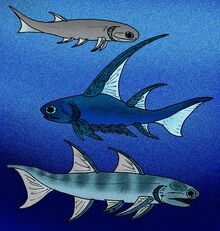Acanthodii or acanthodians (sometimes called spiny sharks) is a paraphyletic class of extinct fish, sharing features with both bony fish and cartilaginous fish. In form they resembled sharks, but their epidermis was covered with tiny rhomboid platelets like the scales of holosteans (gars, bowfins). They represent several independent phylogenetic branch of fishes leading to the still-extant Chondrichthyes.[1]
The popular name "spiny sharks" is a partial misnomer for these early jawed fishes. The name was coined because they were superficially shark-shaped, with a streamlined body, paired fins, and a strongly upturned tail; stout, largely immovable bony spines supporting all the fins except the tail - hence, "spiny sharks"; in retrospect, however, their close relation to modern cartilaginous fish can lead them to be considered "stem-sharks". Fossilized spines and scales are often all that remains of these fishes in ancient sedimentary rocks. Although not sharks or cartilaginous fish, acanthodians did, in fact, have a cartilaginous skeleton, but their fins had a wide, bony base and were reinforced on their anterior margin with a dentine spine. The earliest acanthodians were marine, but during the Devonian, freshwater species became predominant.
There are three orders recognized: Climatiiformes, Ischnacanthiformes and Acanthodiformes. Climatiiforma had shoulder armor and many small sharp spines, Ischnacanthiforma with teeth fused to the jaw, and the Acanthodiforma were filter feeders, with no teeth in the jaw, but long gill rakers. Overall, the acanthodians' jaws are presumed to have evolved from the first gill arch of some ancestral jawless fishes that had a gill skeleton made of pieces of jointed cartilage.
Characteristics[]
The scales of Acanthodii have distinctive ornamentation peculiar to each order. Because of this, the scales are often used in determining relative age of sedimentary rock. The scales are tiny, with a bulbous base, a neck, and a flat or slightly curved diamond-shaped crown.
Despite being called "spiny sharks," acanthodians predate sharks. Scales that have been tentatively identified as belonging to acanthodians, or "shark-like fishes" have been found in various Ordovician strata, though, they are ambiguous, and may actually belong to jawless fishes such as thelodonts. The earliest unequivocal acanthodian fossils date from the beginning of the Silurian Period, some 50 million years before the first sharks appeared. Later, the acanthodians colonized fresh waters, and thrived in the rivers and lakes during the Devonian and in the coal swamps of Carboniferous. But the first bony fishes were already showing their potential to dominate the waters of the world, and their competition proved too much for the spiny sharks, which died out in Permian times (approximately 250 MYA).
Many palaeontologists originally considered the acanthodians close to the ancestors of the bony fishes. Although their interior skeletonswere made of cartilage, a bonelike material had developed in the skins of these fishes, in the form of closely fitting scales (see above). Some scales were greatly enlarged and formed a bony covering on top of the head and over the lower shoulder girdle. Others developed a bony flap over the gill openings analogous to the operculum in later bony fishes. However, most of these characteristics are considered homologous characteristics derived from common placodermancestors, and present also in basal cartilaginous fish.
Taxonomy and phylogeny[]
In a study of early jawed vertebrate relationships, Davis et al. (2012) found acanthodians to be split among the two major clades Osteichthyes (bony fish) and Chondrichthyes (cartilaginous fish). The well-known acanthodian Acanthodes was placed within Osteichthyes, despite the presence of many chondrichthyan characteristics in its braincase.[2] However, a newly described Silurian placoderm, Entelognathus, which has jaw anatomy shared with bony fish and tetrapods, has led to revisions of his phylogeny: acanthodians are now considered to be a paraphyletic assemblage leading to cartilaginous fish, while bony fish evolved from placoderm ancestors.[3]

